Starkey Laboratories CMA 500 User Manual BKLT2837 02 EE XX SPI16 Companion Mic Opman
Starkey Laboratories Inc 500 BKLT2837 02 EE XX SPI16 Companion Mic Opman
User Manual
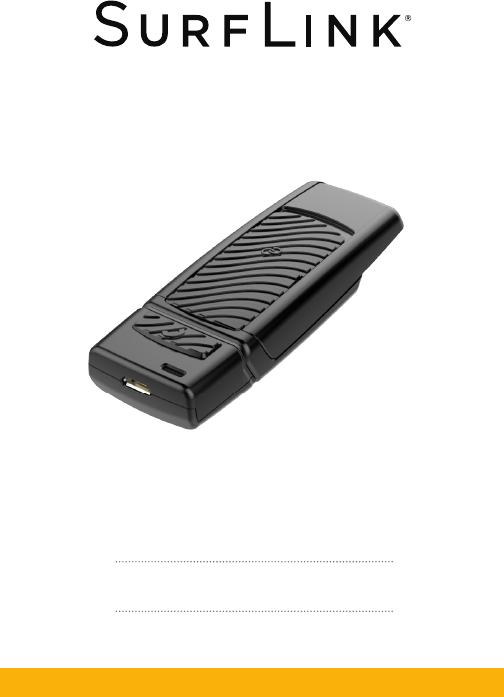
MINI MOBILE
OPERATIONS MANUAL

Table of Contents
Introduction 4
SurfLink Remote Microphone 6
Basic Use 6
Controls Overview 8
Operation 10
Low Battery and Recharging 10
Power On/Off Slider 12
Syncing 13
Built-In Microphones 15
LED 16
How to Wear 17
Streaming Audio 18
Interoperability with Other Accessories 18
Troubleshooting 20
SurfLink Mini Mobile
Basic Use 22
Controls Overview 26
Operation 28
Low Battery and Recharging 28
Multi-function Push-Button 29
Power On/Off 29
Bluetooth Pairing 29
Interacting with Phone Calls 31
Listening to Music 32
Resetting 32
LED 33
Typical Use Cases
Troubleshooting 36
Regulatory Notices 38

Introduction
The SurfLink Mini Mobile system includes both the
SurfLink Remote Microphone and SurfLink Mini Mobile
Adapter.
The SurfLink Remote Microphone is designed to
stream remote microphone audio directly to your
900MHz wireless hearing instruments. When worn
by a distant speaker in noisy environments, SurfLink
Remote Microphone functions as an assistive listening
device.
When SurfLink Mini Mobile Adapter is attached to
SurfLink Remote Microphone, the resulting SurfLink
Mini Mobile system is designed to stream audio
from your Bluetooth device to your 900MHz wireless
hearing instruments.
Streaming – Audio or sound transmitted from
SurfLink Remote Microphone to your 900MHz wireless
hearing instruments.
Package Contents
• SurfLink Remote Microphone
• SurfLink Mini Mobile Adapter
• USB-to-MicroUSB Recharging Cable
• Wall Power Adapter
• Operations Manual
Optional Accessories
• Car Charger Adapter
• Lanyard
Typical Setup
4 5
Hearing Instrument Speaker
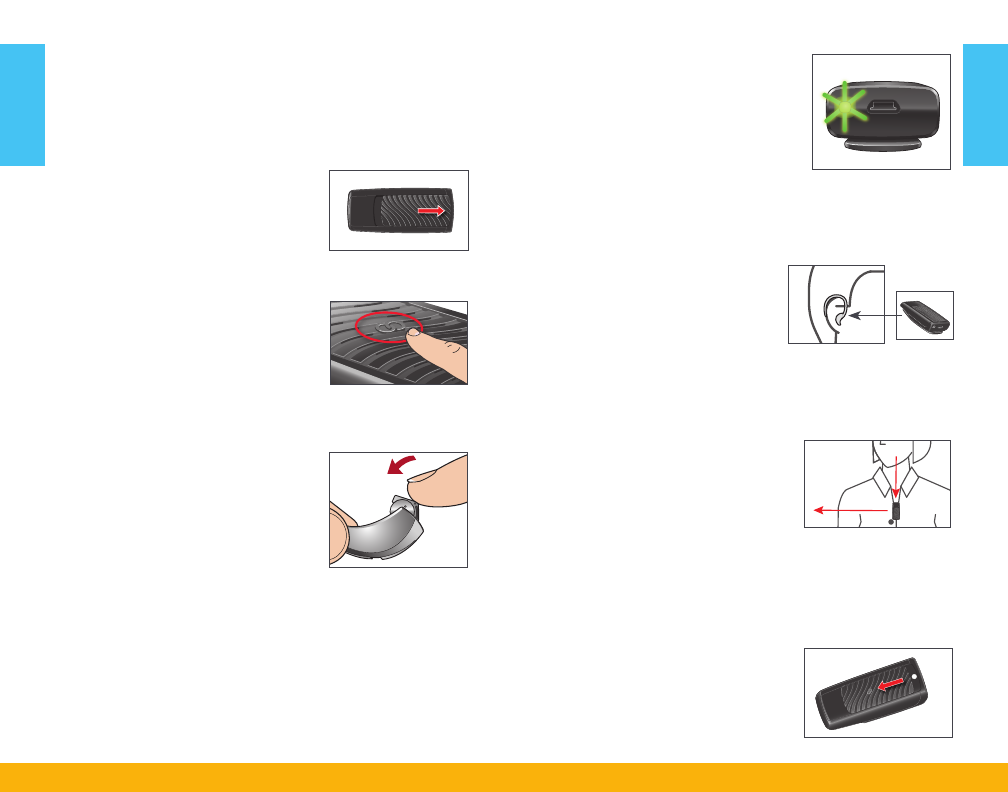
SurfLink Remote Microphone
Basic Use
To quickly start using SurfLink Remote Microphone:
1. Power on SurfLink Remote
Microphone. Green LED
appears for 2 seconds.
2. Press “Sync” icon on
slider button for 5 seconds
until LED starts rapidly
blinking blue.
3. Open one hearing
instrument battery door,
insert battery and close
battery door. Green LED
pulses to
confirm successful sync.
If you only have one hearing
instrument, wait 20 seconds
until red LED pulses.
If you have two hearing
instruments, open second
hearing instrument battery
door, insert battery and
close battery door. Green
LED pulses to confirm
successful sync.
4. Each hearing instrument
should automatically start
streaming audio. Blue
LED slowly pulses when
audio streaming is active.
5. Have a speaker attach
SurfLink Remote
Microphone to their
clothing, within 8”
(20cm) of their mouth is
recommended for best
performance.
6. To stop streaming, turn
off SurfLink Remote
Microphone.
6 7
Basic Use
Basic Use
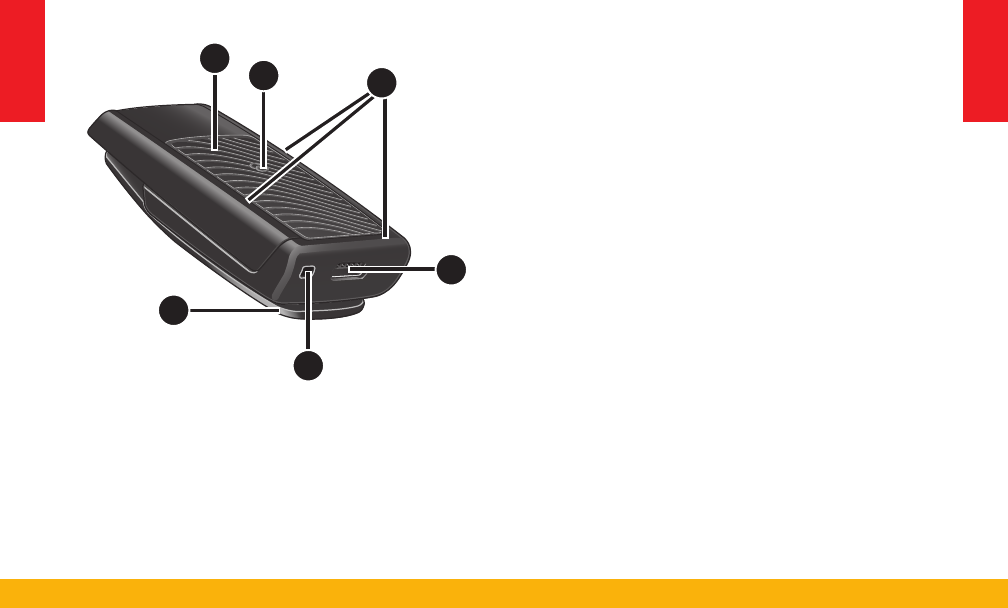
SurfLink Remote Microphone
Controls Overview
1. MicroUSB Jack for Recharging
Recharging via Battery-Charging Cable.
2. Power On/Off Slider
• Moving the slider towards the microUSB jack
powers on SurfLink Remote Microphone.
• Moving the slider away from the microUSB
jack powers off SurfLink Remote Microphone.
3. Syncing
Establishes the relationship between SurfLink
Remote Microphone and hearing instruments.
4. Built-In Microphones
Pick up sound and transmit to hearing
instruments.
5. LED Indicator
Identifies the current state of SurfLink
Remote Microphone.
6. Clip
Affixes SurfLink Remote Microphone
to clothing, lanyard, etc.
2
4
1
6
3
5
8 9
Controls Overview
Controls Overview
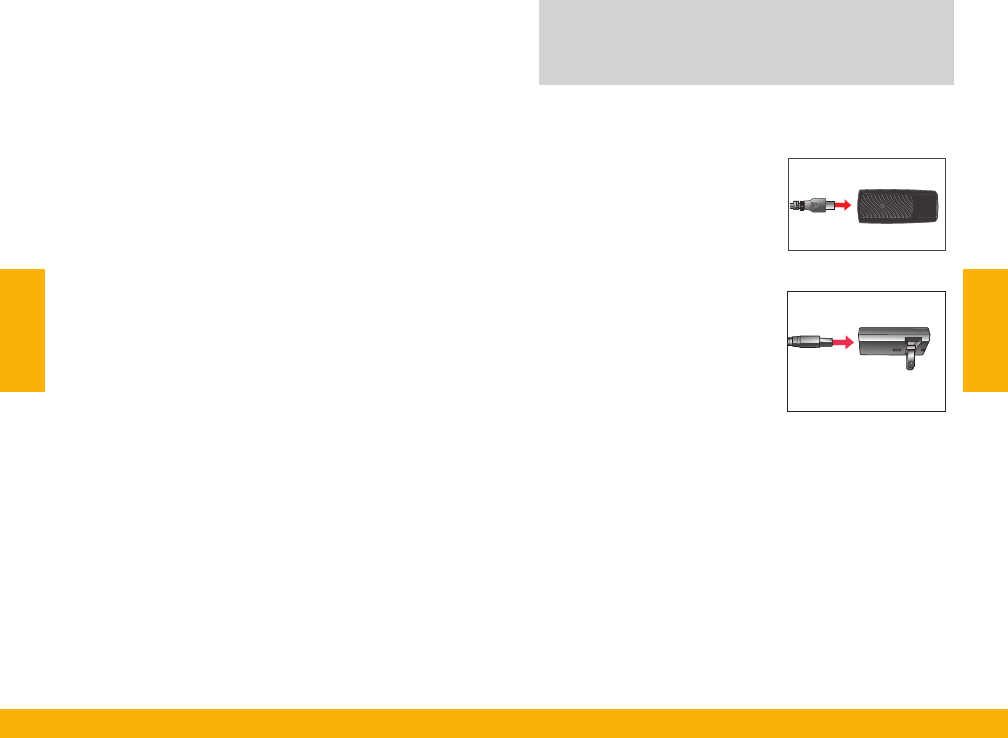
Operation
Low Battery and Recharging
If SurfLink Remote Microphone is on and enters
a low battery condition, the LED slowly pulses
red and provides an audible indicator tone to a
hearing instrument. The indicator tone is distinctly
different from the low battery indicator for a hearing
instrument, so there is no confusion as to which is
experiencing a low battery condition. Once SurfLink
Remote Microphone enters a low battery condition,
the indicator tone will occur about every 5 minutes
until SurfLink Remote Microphone automatically shuts
down, or until a recharging power source is applied.
When SurfLink Remote Microphone is attached
to a power source, its recharging automatically
begins. While SurfLink Remote Microphone is off,
the LED turns solid green during recharging and
turns off when fully charged. While SurfLink Remote
Microphone is on, the LED prioritizes streaming by
slowly pulsing blue, but continues recharging in the
background.
TIP – Recharging SurfLink Remote Microphone can
take longer while streaming audio. Recharging will be
faster when the SurfLink Remote Microphone is off.
Typical Charging Method
To recharge the battery,
attach the microUSB end
of the recharging cable to the
microUSB jack on SurfLink
Remote Microphone.
Attach the USB end of
the recharging cable to a
female USB jack, such as
found on a plugged-in wall
power adapter, car charger
adapter or computer.
10 11
Operation
Operation
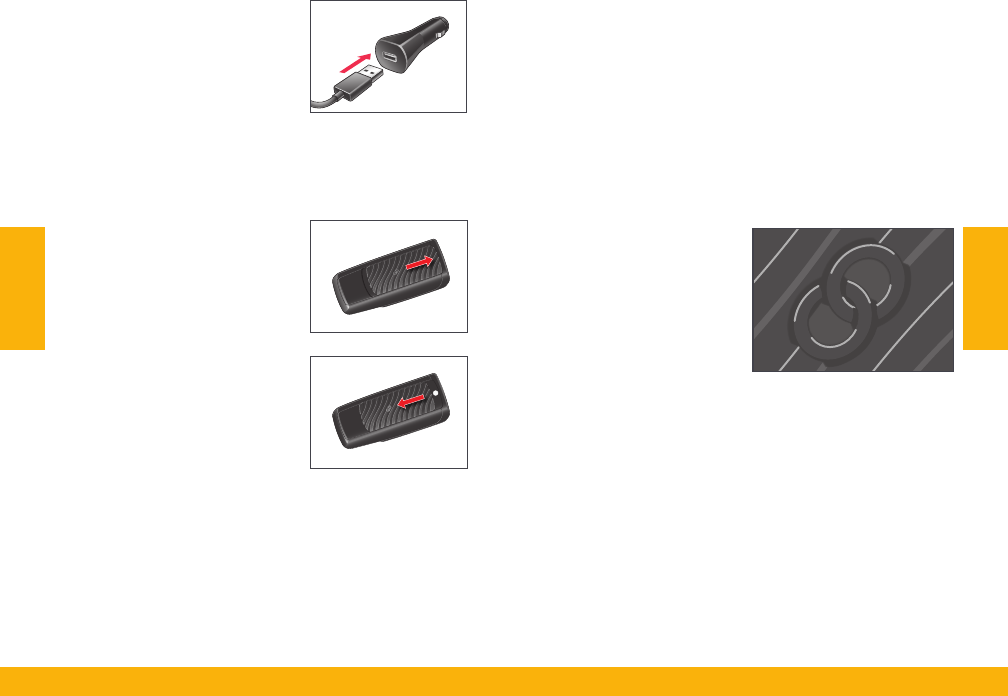
Car Charger Adapter
The SurfLink Remote
Microphone can be recharged
using a car charger adapter.
These adapters can be
obtained from your hearing
professional (ask for part
#52869-000).
Power On/Off Slider
Power On – Move the slider
toward the microUSB end to
turn on. The LED turns green
for 2 seconds to verify power
is on.
Power Off – To stop streaming
audio, move the slider away
from the microUSB end until
the brightly colored surface is
exposed. The LED turns red for
2 seconds to verify power is off.
Syncing
Syncing establishes a relationship between your
hearing instruments and SurfLink Remote Microphone.
For hearing instruments to receive streamed audio
from SurfLink Remote Microphone, you must first
sync the hearing instruments with SurfLink Remote
Microphone. You only have to sync SurfLink Remote
Microphone with your hearing instruments once, as
they will automatically link when both are powered on
and they are within wireless operating range.
To put SurfLink Remote
Microphone into an
active syncing state,
press the “Sync” icon
on the Power On/Off
slider for 5 seconds
until the LED starts
rapidly blinking blue. To sync a hearing instrument
with SurfLink Remote Microphone, open your hearing
instrument battery door, insert a battery, and close
your hearing instrument battery door.
12 13
Operation
Operation
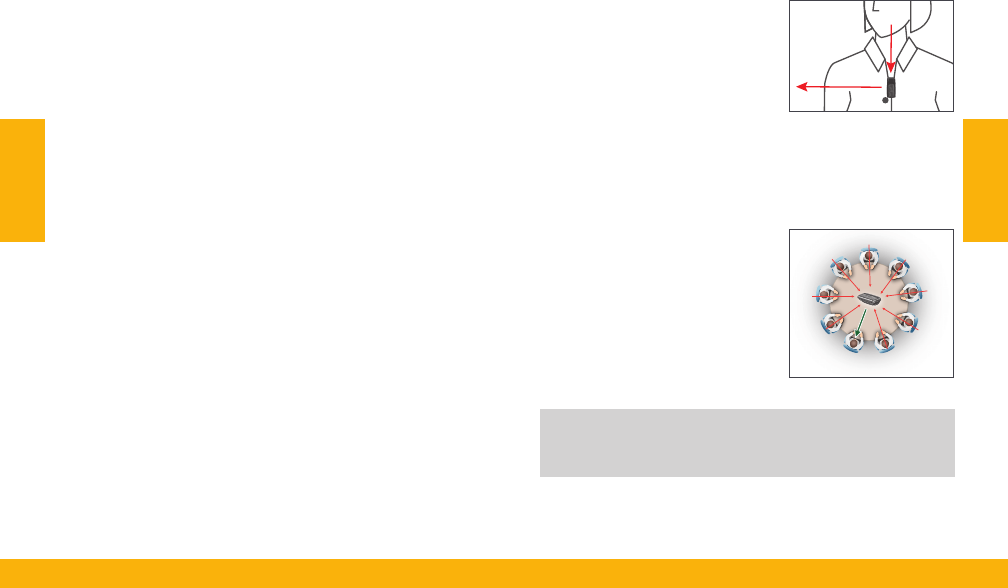
14 15
The SurfLink Remote Microphone remains in an active
syncing state for up to 20 seconds (concluded by red
LED blink), or until one hearing instrument is synced
with it (confirmed by a green LED blink).
After a successful hearing instrument syncing, SurfLink
Remote Microphone continues in an active syncing
state for another 20 seconds (concluded by red
LED blink), or until the second hearing instrument is
synced with it (confirmed by green LED blink).
After successful syncing, each hearing instrument
should automatically start streaming audio. If syncing
did not yield the desired result, then repeat the
process.
To cancel syncing mode, turn off and then turn on
SurfLink Remote Microphone.
The SurfLink Remote Microphone can be synced with
at most one left and one right hearing instrument at
a time. When hearing instruments are synced with
SurfLink Remote Microphone, any previously synced
hearing instruments will be automatically deleted.
Operation
Operation
Built-In Microphones
Depending on SurfLink Remote Microphone’s physical
orientation, it automatically adjusts the microphone
settings to either “Focus” (directional) or “Surround”
(omni-directional).
“Focus” – When SurfLink
Remote Microphone is
body worn, it automatically
prioritizes sound from above
while reducing sounds levels
from other directions. This is
useful for listening to a single
speaker when background noise
is present.
“Surround” – When SurfLink
Remote Microphone is placed
horizontally (on its clip),
it receives sound from all
directions. This setting is useful
for listening to multiple nearby
speakers in quiet environments.
TIP – In noisy environments, move SurfLink Remote
Microphone as close as possible to sound source.
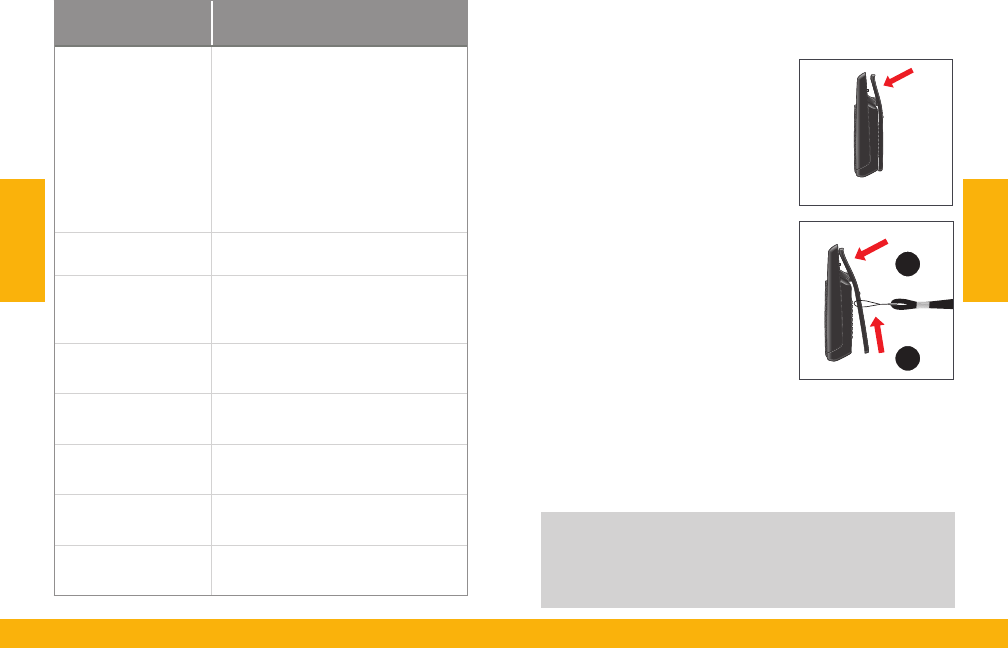
LED
The LED indicator provides helpful information about
SurfLink Remote Microphone:
LED BEHAVIOR SURFLINK REMOTE
MICROPHONE STATE
Off
• SurfLink Remote Microphone is off
and is not attached to a power
source
• If SurfLink Remote Microphone is
off and attached to a power source,
then battery is fully charged.
• If SurfLink Remote Microphone
appears on but is not operational,
then battery may need recharging.
Solid green Battery is recharging and SurfLink
Remote Microphone is off
Green for
2 seconds
• SurfLink Remote Microphone
successfully powers on
• Recharging started
Slow pulsing red Low battery state and SurfLink
Remote Microphone is on
Red for 2 seconds • SurfLink Remote Microphone
powers off
Rapid blinking red • Possible error condition, refer to
Troubleshooting section
Slow pulsing blue • SurfLink Remote Microphone is
streaming audio
Rapid blinking blue • SurfLink Remote Microphone is in
active syncing state
How to Wear
The SurfLink Remote Microphone can be affixed to
clothing or worn on a lanyard. For better performance,
SurfLink Remote Microphone should be within 8”
(20cm) of the speaker’s mouth.
Clip – Gently press the clip
as shown. Slide clip opening
onto clothing and release
clip. Ensure SurfLink Remote
Microphone is securely affixed
to clothing.
Lanyard (optional) –
1. Gently press the clip
as shown.
2. Insert lanyard loop into
clip opening and lift
loop toward top of clip.
Release clip. Ensure the
lanyard is securely attached to
SurfLink Remote Microphone.
Lanyards can be obtained from your hearing
professional (ask for part #53262-000).
TIP – To achieve better signal-to-noise performance,
a hearing professional can adjust (mute or attenuate)
your hearing instrument microphones during SurfLink
Remote Microphone use.
2
1
16 17
Operation
Operation

Streaming Audio
After SurfLink Remote Microphone powers on,
it automatically begins streaming audio to synced
hearing instruments. The LED slowly pulses blue to
confirm that audio streaming is active and SurfLink
Remote Microphone’s battery is operational.
When SurfLink Remote Microphone is turned off,
it automatically stops streaming audio.
The user can adjust streamed audio volume level
via their hearing instruments. The SurfLink Remote
Microphone does not contain an integrated volume
control.
TIP – Try placing Surflink Remote Microphone near a
television. To achieve a comfortable listening level,
adjust the SurfLink Remote Microphone distance
from the television speakers or modify the television
volume level.
Interoperability with Other Accessories
If you also use a SurfLink Mobile, then, its phone
call streaming will take priority over the SurfLink
Remote Microphone audio stream. When a SurfLink
Mobile phone call stream ends, SurfLink Remote
Microphone’s audio stream automatically returns to
a hearing instrument.
SurfLink Remote Microphone streamed audio is
equal in priority to SurfLink Media streamed audio
with preference being given to the first available
audio source.
If you use a SurfLink Remote or SurfLink Mobile, then
remote control commands will continue to be sent to
your hearing instruments.
18 19
Operation
Operation

SYMPTOM / ISSUE POSSIBLE CAUSE POSSIBLE REMEDY
One (or both) hearing
instruments unexpectedly
drop out of audio
streaming.
Hearing instrument may be on
the edge of wireless range. Move closer to SurfLink Remote Microphone.
Battery level in hearing instrument can
no longer support audio streaming. Replace hearing instrument battery with new one.
Large object, such as furniture or
a wall, may be degrading signal.
For best performance, your hearing instruments should be
within line-of-sight.
Outdated hearing instrument firmware. Hearing professional can update hearing instruments with the
most recent firmware.
LED is slowly pulsing
blue, but no streamed
sounds are heard in the
hearing instruments.
Hearing instruments are not
within wireless range. Move closer to SurfLink Remote Microphone.
Hearing instruments are not
properly synced with SurfLink
Remote Microphone.
Sync hearing instruments with SurfLink Remote Microphone.
Battery level in hearing instrument
cannot support audio streaming. Replace hearing instrument battery with new one.
LED is rapidly blinking
red continuously. Possible error condition. Turn off SurfLink Remote Microphone, wait 15 seconds, and
turn on SurfLink Remote Microphone.
Difficult to hear speaker
in noisy environments.
SurfLink Remote Microphone
may be too far from speaker. Move SurfLink Remote Microphone closer to speaker’s mouth.
SurfLink Remote Microphone
may not be positioned for optimal
streaming.
Re-orient SurfLink Remote Microphone spatially by turning a
few degrees to right or left.
Signal-to-noise performance
not optimal for current hearing
instrument memory.
Change to memory optimized by your hearing professional for
use with SurfLink Remote Microphone.
20 21
Troubleshooting
Troubleshooting
Troubleshooting
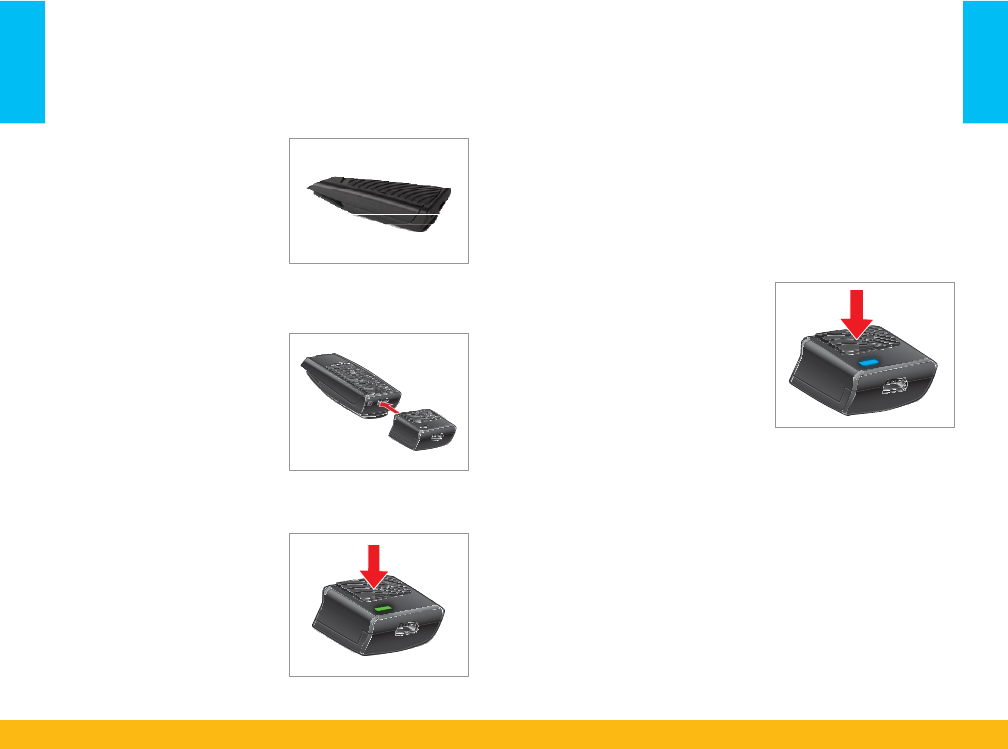
SurfLink Mini
Mobile
Basic
Use
To
quickly
s
t
a
r
t
using SurfLink
Mini
M
obil
e
:
1.
Ensure
SurfLink
Remote Microphone
has been
pr
operly
setup with your hearing
instruments and is in
powered on state.
4. Put your cell phone into Bluetooth
pairing mode.
NOTE: Some devices may
ask
for the SurfLink
Mini Mobile Adapter PIN, which is 0000.
5. While the green LED
is slowly pulsing,
double-click the push-
button. The LED starts
rapidly blinking blue,
which puts SurfLink
Mini Mobile
Adapter
2. Insert the male
microUSB
jack
of
SurfLink
Mini
Mobile
Adapter into SurfLink
Remote Micr
ophone’
s
female
microUSB
jack.
into Bluetooth Pairing
Mode.
6. On your Bluetooth device, select
SurfLink
Mini
to complete the pairing process.
3. To turn on SurfLink
Mini Mobile
Adapter
,
press its push-button
for 2 seconds and
release when the
green LED appears.
22
23
Basic Use
Basic Use
x2
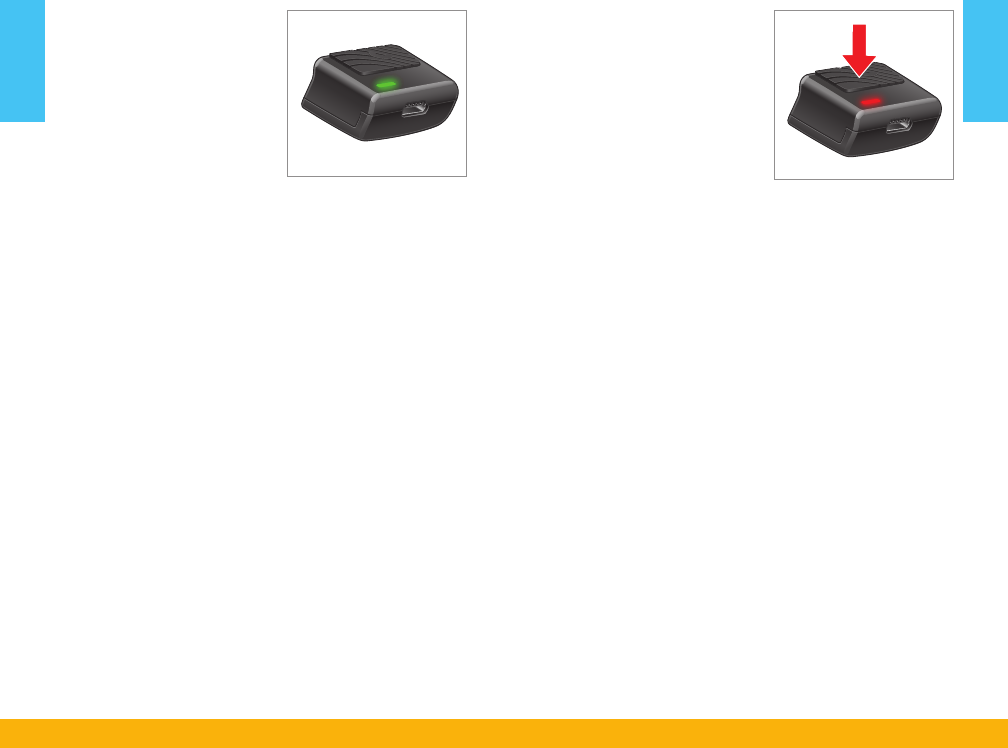
7. A green LED confirms
a successful Bluetooth
pairing.
8. To verify your setup, ensure LED is slowly
pulsing blue and either:
• Play music on your Bluetooth device
• Have someone call your Bluetooth device
o When you hear the incoming call ringtone
in your hearing instruments, briefly press
and release the push-button on SurfLink
Mini Mobile Adapter.
o Speak into SurfLink Mini Mobile Adapter
microphone.
o To end the call, briefly press and
release the push-button.
9. To turn off SurfLink Mini
Mobile Adapter, press
the push-button for 2
seconds and release
it. The red LED briefly
appears to provide
confirmation.
24 25
Basic Use
Basic Use
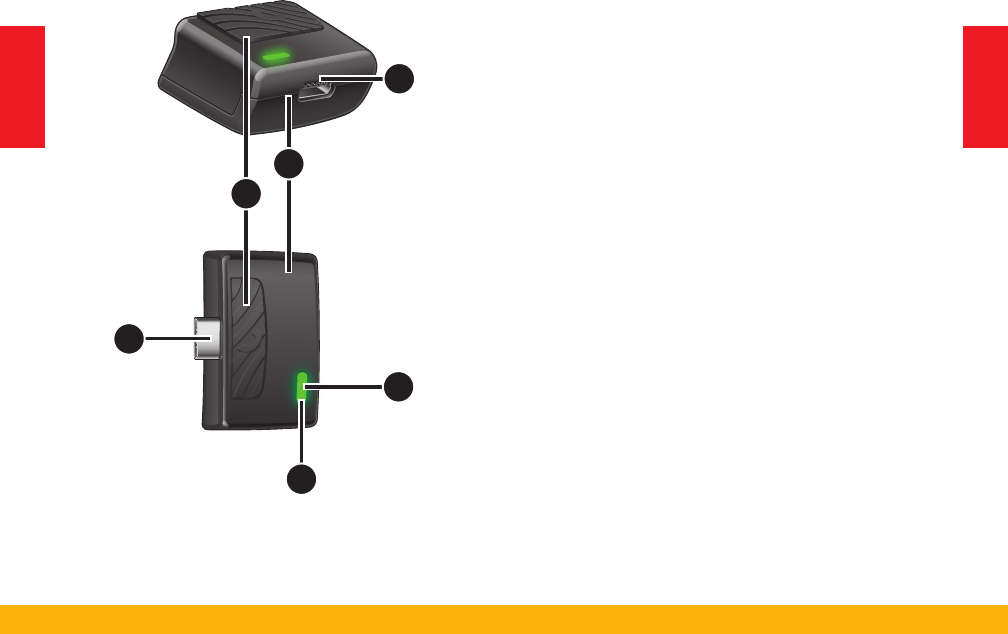
26 27
2
6
3
5
1
4
SurfLink Mini Mobile
Controls Overview
1. SurfLink Mini Mobile Adapter
2. Male MicroUSB Jack
Attaches SurfLink Mini Mobile Adapter
to SurfLink Remote Microphone.
3. Multi-Function Push-Button
Assumes different functionality depending
on the current operational state of SurfLink
Mini Mobile Adapter.
4. LED Indicator
Identifies the current state of SurfLink Mini
Mobile Adapter.
5. Built-In Microphone
Picks up your voice and transmits to caller
during phone calls.
6. Female MicroUSB Jack
Recharges via battery-charging cable.
Controls Overview
Controls Overview
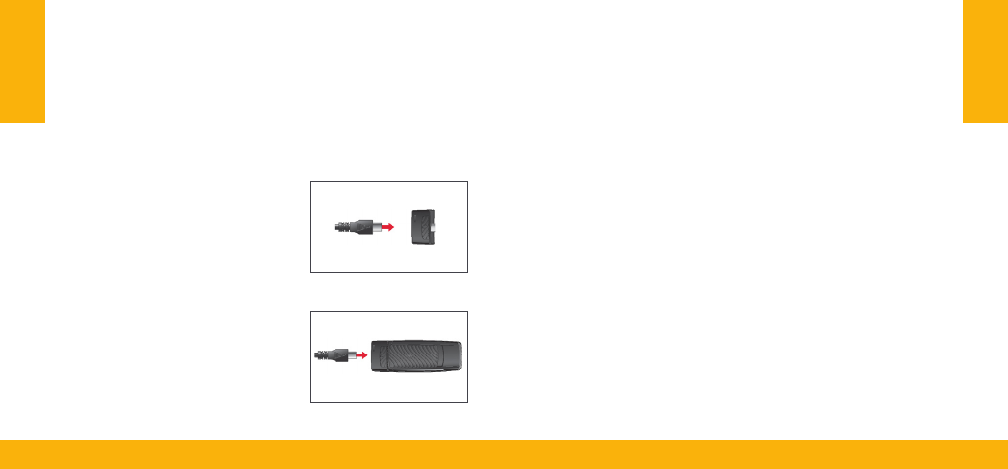
Operation
Low Battery and Recharging
If SurfLink Mini Mobile Adapter is on and enters a low
battery condition, the LED slowly pulses red until it
automatically shuts down, or until a recharging power
source is applied. When the Mini Mobile Adapter is
attached to a power source, the LED becomes solid
green and recharging automatically begins. When
power is on, the solid green LED will be interrupted
by other LED behaviors. When the battery is fully-
charged, the solid green LED turns off.
Typical Charging Method
To recharge the battery, attach the microUSB end of
the recharging cable to the female microUSB jack on
SurfLink Mini Mobile Adapter. Attach the USB end of
the recharging cable to a female USB jack, such as
found on a plugged-in wall
power adapter, car charger
adapter, or computer.
You can recharge both SurfLink
Mini Mobile Adapter and
SurfLink Remote Microphone
at the same time while they
are attached. While recharging,
you can stream audio for
extended periods.
Multi-Function Push-Button
Powering On/Off
Power On – When power is off, press the push-button
for 2 seconds and release it. The LED briefly turns
green to verify power is on.
Power Off – When power is on, press the push-button
for 2 seconds and release it. The LED briefly turns red
to verify power is off.
Bluetooth Pairing
For SurfLink Mini Mobile Adapter to receive streamed
audio from your Bluetooth device, you must first
Bluetooth pair it. To start the Bluetooth pairing
process, put your Bluetooth device into pairing
mode. If you are unfamiliar with the Bluetooth pairing
process, consult your Bluetooth device’s operations
manual.
To put SurfLink Mini Mobile Adapter into an active
Bluetooth pairing state, ensure it is powered on and
not Bluetooth-connected to other devices (the green
LED will be slowly pulsing). Double-click the push-
button so that the LED starts rapidly blinking blue.
The Mini Mobile Adapter remains in an active pairing
state for up to 60 seconds. When it appears, select
the product name (SurfLink Mini) on your Bluetooth
device. A green LED for 2 seconds confirms a
28 29
Operation
Operation

Bluetooth
Overview
Bluetooth is a
wireless communication
technology
used
to
transmit
audio and data. To interoperate with
SurfLink
Mini Mobile, a
Bluetooth-enabled
device
must support at least one of the following Bluetooth
profiles:
• To make/receive phone calls, your Bluetooth device
must support the “Hands-Free” (HFP) profile.
• To listen to music, your Bluetooth device must
support the “Media” (A2DP) profile.
To enable Bluetooth
communication, these pr
ocesses
must be completed:
Pairing
–
Establishes
a
relationship
between a
Bluetooth device and
SurfLink
Mini Mobile Adapter.
Connecting
–
Establishes
the ability to actively
stream
audio from a
previously
paired Bluetooth
device to your
hearing instruments
via
SurfLink
Mini
Mobile Adapter.
successful
pairing with the
Bluetooth device
while
a rapid blinking red
LED denotes
an unsuccessful
pairing attempt. To
cancel
pairing mode on Mini
Mobile Adapter,
press
the
push-button
for 2
seconds
and
release
it,
which powers
off the Mini Mobile
Adapter.
Interacting
with
Phone
Calls
The SurfLink
Mini Mobile Adapter
allows
you
to
accept,
reject,
hang
up, and
transfer
phone
calls
to/
from a
Bluetooth connected
phone.
Accept – When you hear the incoming call
ringtone in your hearing instruments, briefly
press and release the push-button on
Mini
Mobile
Adapter
.
You
only need to pair
SurfLink
Mini Mobile
Adapter with your phone one time,
as
they should
automatically Bluetooth connect when
both are
powered on and they
are
within
wireless
operating
range. The
Mini Mobile Adapter
can
be paired and
connected
with up to 2
Bluetooth devices
at a time.
Reject – When you hear the incoming call
ringtone in your hearing instruments, press the
push-button on Mini Mobile Adapter for more
than 2 seconds.
Release
the button after the
ringtone stops.
Hang Up – During an active phone call, briefly
press and release the push-button on
Mini
Mobile
Adapter
.
Transfer
– During an active phone call, press
the push-button on Mini Mobile Adapter
for
more than 2 seconds to move the call fr
om
Mini Mobile Adapter to the phone. This allows
you to directly conduct the call via the phone,
if
desired.
Re-press
the push-button for more
than 2 seconds to move the call back to
Mini
Mobile
Adapter
.
30
31
Operation
Operation

During an
active
phone
call, SurfLink
Mini Mobile
Adapter
picks
up your
voice
so that the
caller
can
hear
it during the
conversation.
In
noisy envir
onments,
position Mini Mobile Adapter
closer
to your mouth.
LED
The LED
indicator
provides
helpful
information
about
SurfLink
Mini Mobile Adapter:
Listening
to
Music
or Other
Streamed
Audio
To
receive music
or other audio in your hearing
instruments, simply
play the audio on your Bluetooth
connected device
and it will be
transmitted
via
SurfLink
Mini Mobile. It is not
necessary
to
press
the
push-button
on
SurfLink
Mini Mobile Adapter.
R
e
s
et
t
ing
To
reset SurfLink
Mini Mobile Adapter
back
to factory
settings, ensure
it is powered on and not Bluetooth-
connected
to other
devices (the
green
LED
will be
slowly
pulsing).
Double-click
the
push-button
so that
the
LED starts
rapidly blinking blue.
Press
the push-
button for 12
seconds
until
LED starts
rapidly blinking
red.
The
Mini Mobile Adapter
automatically turns
off
following a reset.
32
33
Operation
Operation
LED
BEHAVIOR
SURFLINK
MINI
MOBILE
STATE
Off
Off
•
Mini Mobile Adapter is off and is not
attached
to a power source.
•
If Mini Mobile Adapter is off and is
attached
to a power
source,
then
battery
charging
is complete.
Slow pulsing
green
•
Mini Mobile Adapter is on, but not
connected
to
Bluetooth
device.
Green
for 2
seconds
•
Mini Mobile Adapter
successfully
powers
on.
•
Mini Mobile Adapter
successfully
pairs
with
Bluetooth
device.
Solid
green
•
Recharging
and power is off.
•
When
Mini Mobile Adapter is recharging
and power is on, then solid green will
be briefly interrupted by other LED
behaviors.
Slow pulsing
red
•
Low
battery
state
and Mini Mobile
Adapter is on.
Red
for 2 seconds
•
Mini Mobile Adapter
powers
off.
Rapid blinking
red
•
Failure
to pair with
Bluetooth
device.
•
Reset
to
factory
settings.
Slow pulsing
blue
•
Mini Mobile Adapter is
connected
to
Bluetooth
device.
Rapid blinking
blue
•
Mini Mobile Adapter is attempting to pair
with
Bluetooth
device.
`

Typical Use Cases
To effectively use SurfLink Mini Mobile Adapter, it will
need to be within easy reach so that you can quickly
press the push-button to answer calls and speak into
the built-in microphone. Typical operating scenarios
include:
SCENARIO OPTIMAL CONFIGURATION
You want to stream SurfLink Remote Microphone audio from
a distant talker to your hearing instruments.
Distant talker wears just SurfLink Remote Microphone,
which is powered on.
OR
Distant talker wears SurfLink Remote Microphone (which
is powered on) attached to SurfLink Mini Mobile Adapter
(which is powered off).
You want to stream an active phone call to your hearing
instruments.
SurfLink Remote Microphone is attached to SurfLink Mini Mobile
Adapter and both are powered on.
• Press the push-button on Mini Mobile Adapter to answer the
phone call.
You want to stream music or other audio to your hearing
instruments.
SurfLink Remote Microphone is attached to SurfLink Mini Mobile
Adapter and both are powered on.
• Start audio on your Bluetooth device.
You want your hearing instrument microphones to be active,
but allow for possibility of incoming phone calls.
SurfLink Remote Microphone is attached to SurfLink Mini Mobile
Adapter and both are powered on.
• There is no active streaming from the cell phone.
You want your hearing instrument microphones to
be active, but still receive smartphone alerts (text messages,
emails, etc.).
SurfLink Remote Microphone is attached to SurfLink Mini Mobile
Adapter and both are powered on.
• Smartphone briefly passes along alerts as they occur.
34 35
Operation
Operation

Troubleshooting
SYMPTOM / ISSUE POSSIBLE CAUSE POSSIBLE REMEDY
Streamed audio is too
loud or too soft in hearing
instruments.
Bluetooth device is
streaming at non-optimal
volume.
Adjust volume control on the Bluetooth device.
LED is slowly pulsing blue,
but no streamed audio is
heard in the hearing
instruments.
SurfLink Mini Mobile
Adapter may be unattached
from SurfLink Remote
Microphone.
Ensure Mini Mobile Adapter is properly attached to
Remote Microphone.
SurfLink Remote Microphone
may be powered off. Turn on SurfLink Remote Microphone.
Caller cannot hear your
voice during phone calls.
SurfLink Mini Mobile may
be too far from your mouth. Move Mini Mobile closer to your mouth.
Streamed Bluetooth audio
quality is inconsistent.
Bluetooth device may be
on the edge of wireless
range.
Move Bluetooth device closer to SurfLink Mini Mobile.
Battery level in SurfLink
Mini Mobile Adapter is
getting low.
Recharge Mini Mobile Adapter.
Large object, such as a
human body or a wall, may
be degrading signal.
For best performance, SurfLink Mini Mobile should be within
line-of-sight of your Bluetooth device.
Smartphone alerts are not
always received. Alert duration is too short. Lengthen alert tone to allow sufficient time for streaming to start.
36 37
Troubleshooting
Troubleshooting

•
Insert small screwdriver into a side housing corner and
pry apart the housing halves.
•
Cut the battery wires from the circuit board to
pr
event
accidental shorting.
•
Pry
the battery away from the
microUSB
using your
fingers.
Intended
Use
The
SurfLink
Remote Microphone is an
accessory
to a
wireless
air conduction hearing instrument. It is
intended
to
wirelessly
transmit audio
signals
from the location of the
SurfLink
Remote Microphone directly to an air conduction
hearing instrument.
The
SurfLink
Mini Mobile Adapter is an
accessory
to a
wireless
air conduction hearing instrument. It is
intended
to
wirelessly
transfer audio
signals
between a Bluetooth-
enabled device and hearing instruments via the SurfLink
Remote Microphone allowing
users
to better participate in
phone conversations.
The
SurfLink
Remote Microphone and
SurfLink
Mini
Mobile
Adapter are classified
as
a Type B applied part under the
IEC
60601-1 medical instrument standard.
SurfLink
Remote Microphone and
SurfLink
Mini
Mobile
Adapter are designed to comply with the most stringent
Standards
of International Electromagnetic
Compatibility
.
However, it is still possible that you may experience
interference caused by power line disturbances,
airport
metal detectors, electromagnetic fields from other medical
devices, radio
signals
and electrostatic discharges.
SurfLink
Remote Microphone and
SurfLink
Mini
Mobile
Adapter are designed to be cleaned with a damp cloth
moistened with soapy water.
Regulatory
Notices
Required
Information
Waste from electronic equipment must
be
handled according to local
r
egulations.
Instructions
for
Disposal
of Old Electronics
Paradigm encourages, and your local community laws may
require, that your
SurfLink
Remote Microphone
and/or
SurfLink
Mini Mobile Adapter be disposed of via your local
electronics recycling/disposal process.
The below instructions are provided for the benefit
of
disposal/recycling personnel.
Please
include this manual
with your device when disposing of your
SurfLink
Remote
Microphone and/or
SurfLink
Mini Mobile
Adapter
.
For Disposal/Recycling Personnel
Only
These
products contain a Lithium Ion Polymer battery.
To remove this battery from
SurfLink
Remote Microphone:
•
Power off the
SurfLink
Remote Microphone.
•
Insert small screwdriver into the side housing crevice
just above the clip spring and pry apart the housing
halves.
•
Unplug the battery connector from the circuit board
to
prevent accidental shorting.
•
Pry
the battery away from the back plate using a
wide flat blade.
To remove this battery from the
SurfLink
Mini
Mobile
Adapter:
•
Power off the
SurfLink
Mini Mobile
Adapter
.
38
39
Regulatory
Notices
Regulatory
Notices

If you use other medical devices or wear implantable
medical devices
such as
defibrillators or
pacemakers
and
are concerned that your
SurfLink
Remote Microphone and/
or
SurfLink
Mini Mobile Adapter might
cause
interference
with your medical device, please contact your physician or
the manufacturer of your medical device for information
about the risk of disturbance. Neither
SurfLink
Remote
Microphone nor
SurfLink
Mini Mobile Adapter should be
used during an MRI procedure.
Use
on Aircrafts
Neither
SurfLink
Remote Microphone nor
SurfLink
Mini
Mobile Adapter should be used on aircrafts unless
specifically permitted by the flight personnel.
International
Use
SurfLink
Remote Microphone and
SurfLink
Mini Mobile
Adapter are approved to operate at radio frequencies that
are specific to your country or region and might not be
approved for use outside your country or
r
egion.
Be aware that operation during international travel may
cause
interference with other electronic devices, or other
electronic devices may
cause
interference with your SurfLink
Remote Microphone and/or
SurfLink
Mini Mobile Adapter.
The batteries in your
SurfLink
Remote Microphone and
SurfLink
Mini Mobile Adapter are not replaceable. Do not
attempt to replace the battery.
FCC/IC Information
SurfLink
Remote Microphone
FCC ID: EOA-CM
IC: 6903A-CM (Model 400)
SurfLink
Mini Mobile Adapter
FCC ID: EOA-CMA
IC: 6903A-CMA (Model 500)
FCC/IC
Notice
This device complies with part 15 of the FCC rules and
with
Industry Canada's license-exempt RSS
standard(s).
Operation is subject to the following
two conditions:
(1)
This device may not
cause
harmful
interference, and
(2)
this device must accept
any
interference
received, including interference that may cause undesired
operation of the device.
NOTE: The manufacturer is not responsible for any radio
or TV interference caused by unauthorized modifications
to this equipment.
Such
modifications could void the user’s
authority to operate the equipment.
Note FCC/IC
Cet appareil est conforme à la partie 15 des
règlements de la FCC et avec la (les) norme (s) RSS
exempte de licence d'Industrie Canada.
Le fonctionnement est soumis aux Deux conditions:
(1) Cet appareil ne doit pas causer d'interférences
nuisibles et (2) cet appareil doit accepter toute
interference reçus, y compris les interférences qui
peuvent causer des fonctionnement du dispositif.
40
41
Regulatory
Notices

Regulatory Information
Regulatory Information
The SurfLink Remote Microphone and SurfLink Mini Mobile Adapter are
designed to the following temperature ranges:
•Operating: -10 to +45 degrees C (14 to 113 degrees F), humidity ≤ 95%
non-condensing
•Battery Charging: 0 to +45 degrees C (32 to 113 degrees F),
humidity
≤
95% non-condensing
•Storage:-20 to +63 degrees C (-4 to 145 degrees F).
We are required by regulations to provide the following warnings:
WARNING:
Use
of SurfLink Remote Microphone or SurfLink Mini
Mobile
Adapter
directly next to other electronic equipment should be
avoided
because
it could result in improper performance. If
such
use
is
necessary,
note
as
to whether your hearing aids and the other equipment
are operating normally.
WARNING:
Use
of
accessories,
components or replacement parts other
than those provided by the
manufacturer
of SurfLink Remote Microphone
or SurfLink Mini Mobile
Adapter
could result in increased
electromagnetic
emissions
and
decreased
electromagnetic immunity and
could result in degradation of performance.
WARNING: If Portable
Radio Frequency communications
equipment is
used closer than 30 cm
(12
inches)
from SurfLink Remote Microphone or
SurfLink Mini Mobile Adapter, degradation of the performance of SurfLink
Remote Microphone or SurfLink Mini Mobile Adapter could result. If this
occurs,
move away from the
communications
equipment.
41a
41b
WIRELESS
TECHNICAL DESCRIPTION
The European version of the SurfLink Remote Microphone operates in the
863-865 MHz band with a maximum effective radiated power of 10 dBm.
with
transmission
modulation type of 342KFXD. The
receiver
section of the
radio
has
a bandwidth of 300kHz.
The North American version of the SurfLink Remote Microphone operates
in the 902-928 MHz band with a maximum effective radiated power of 20
dBm. with
transmission
modulation type of 508KF1D. The
receiver
section
of the radio
has
a bandwidth of 300kHz
The SurfLink Mini Mobile Adapter operates in the 2.4-2.4835 GHz band
with a maximum effected radiated power of 5 dBm with transmission
modulation type of
990KF1W
. The
receiver
section of the radio
has
a
bandwidth of 1 MHz.
SurfLink Remote Microphone and SurfLink Mini Mobile Adapter
have
been
tested to, and
have passed,
the following
emissions
and immunity tests:
•
IEC
60601-1-2 radiated immunity
requirements
for a Group 1
Class
B
device
as
stated in
CISPR
11.
•
RF
radiated immunity at a field level of 10 V/m between 80
MHz
and 2.7
GHz as
well
as
higher field
levels
from
communications
decides
as
stated
in Table 9 of
IEC
60601-1-2.
•
Immunity
to power
frequency
magnetic fields at a field level of 30 A/m.
•
Immunity
to
ESD levels
of +/- 8
kV
conducted
discharge
and +/- 15
kV
air
discharge.
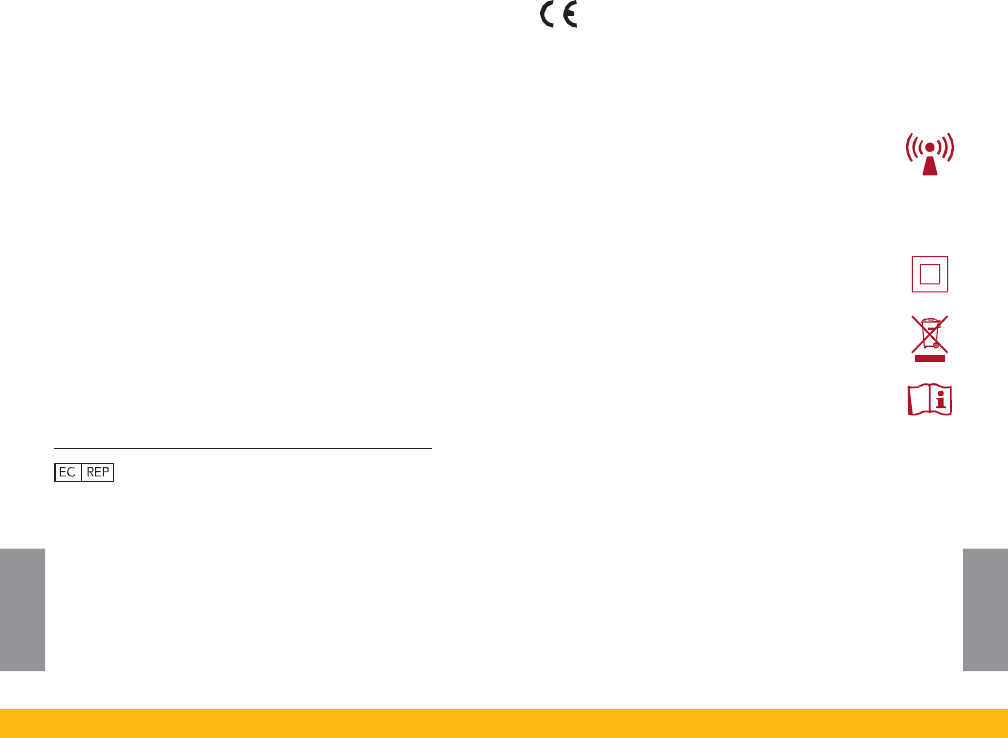
NOTE: Le manufacturier n’est pas responsable
de
l’interférence créée par la modification de cet équipement
lors de l’écoute du téléviseur ou de la radio. De telles
modifications pourraient entrainer la révocation
de
l’autorité
de l’utilisateur à opérer cet équipement.
The European version of the
SurfLink
Remote Microphone
operates in the 863-865 MHz band with a maximum
effective radiated power of 10 dBm.
The
SurfLink
Mini Mobile Adapter operates in the
2.4-2.4835 GHz band with a maximum ef
fected
radiated power of 10 dBm.
Hereby, Paradigm declares that the
SurfLink
Remote
Microphone and
SurfLink
Mini Mobile Adapter are in
compliance with the
essential
requirements and other
relevant provisions of Directive 1999/5/EC. A copy
of
the Declaration of Conformity can be obtained from the
addresses
below
.
Paradigm, Inc.
6600 Washington Ave. South
Eden
Prairie,
MN 55344 USA
The
following
symbols are used
in this document
and on both the
Remote Microphone
and
Mini Mobile Adapter:
This device produces
and receives
radio
frequency energy.
Interference
may occur
in the
vicinity
of equipment
marked
with the following symbols:
Class
II device
Dispose
of properly
Consult operations
manual
Paradigm, Inc. European Headquarters
Wm. F. Austin House, Bramhall Technology Park
Pepper Road, Hazel Grove, Stockport
SK7
5BX
United Kingdom
42
43
Regulatory
Notices
Regulatory
Notices

44 45
Notes Notes

© 2017 Paradigm, Inc. All Rights Reserved.
85269-007 1/17 BKLT2912-00-EE-XX